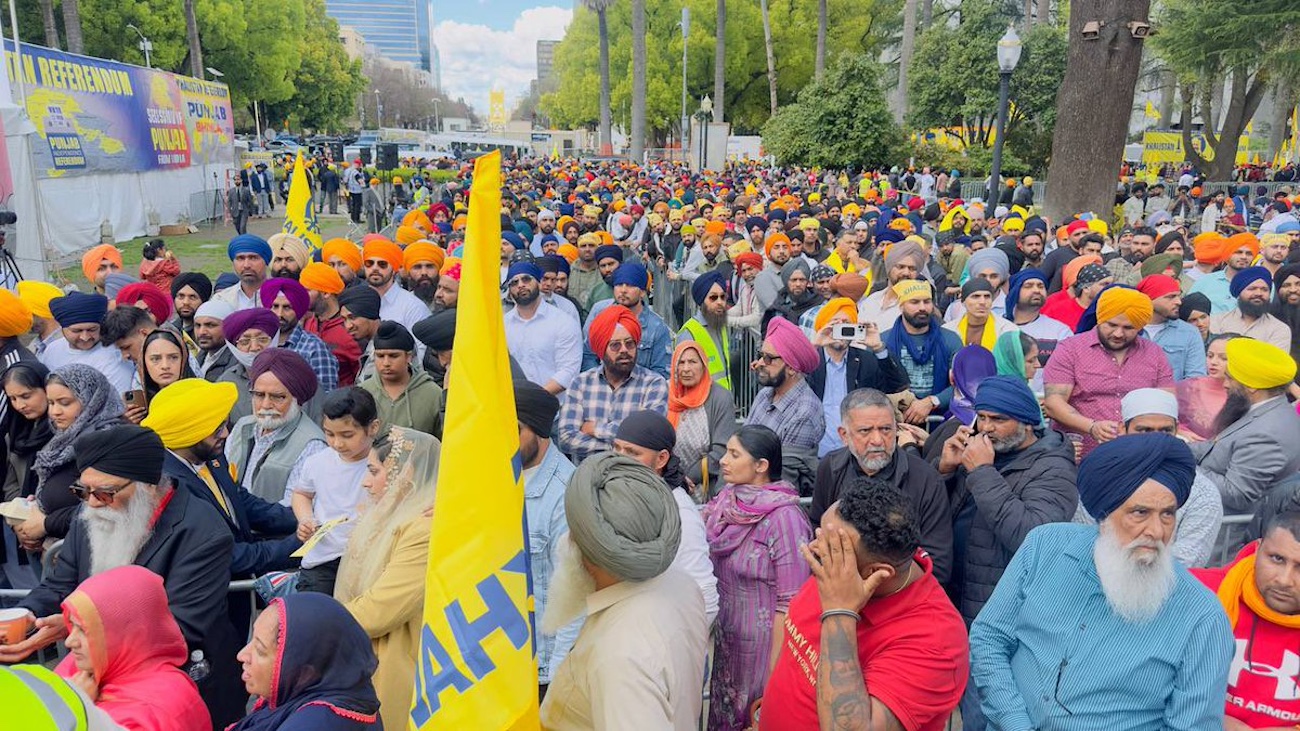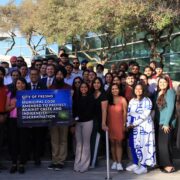Thousands of Sikhs Gather in Sacramento to Vote on ‘Referendum’ for Creation of Independent Country of Khalistan
- Organized by Sikhs for Justice, an activist group that has been banned in India since 2019, a similar such event was held in February in San Fransisco.

Thousands of Sikhs gathered in Sacramento on March 31, to vote on a ‘referendum’ on Sikh independence. The Sacramento Bee estimates that 40,000 people voted at the event. They came in cars, buses, and trains, waving bright yellow-and-blue flags to the State Capitol to participate in a non-binding ‘referendum’ to establish an independent nation in the region of Punjab. They waited patiently in long lines to cast their votes for Khalistan — an independent country of their own. The event was organized by Sikhs for Justice, an activist group that has been banned in India since 2019.
20,000+ In Attendance At 9:00AM – Ardas To Declare Jathedar Kaunke As “QUAMI SHAHEED”
— Gurpatwant Singh Pannun (@SFJGenCounsel) March 31, 2024
31 March
California State Capitol
Sacramento
Voting for Khalistan Referendum going on at Shaheed Jathedar Kaunke Voting Center till 5:00 pic.twitter.com/K1tEcoG8ST
Khalistan Referendum Sacramento 🇺🇸 first votes cast by the family of Shaheed Jathedar Gurdev Singh JI Kaunke pic.twitter.com/B05Z4uRj0D
— Dal Khalsa UK 🇬🇧🏴 🦅 (@DalKhalsaUK) April 1, 2024
Over 60,000 Panjabis in California's Sacramento voted in Khalistan Referendum today, with hundreds waiting in lines. Over 125,000 in California's San Francisco turned out to cast their votes in the first phase of referendum on Jan 28, 2024. The next date for another Referendum is… pic.twitter.com/hrzJKUL7PM
— Sarbraj Singh Kahlon (@sarbrajskahlon) April 1, 2024
As the San Francisco Standard noted, the ballot measure, known as the Khalistan referendum, is nonbinding, “meaning even if the majority of voters favor independence, it won’t guarantee a new nation.” The first such referendum was first held in London on Oct. 31, 2021. Since then, similar events have been held in Canada, Australia, and other places with large Sikh populations.
According to the Sikh Coalition, Sikhs have been in America for over 125 years. There are over 500,000 Sikhs in the country, out of which half live in California.
Jaswant Singh, one of the attendees told ABC210 that the Indian government is “killing innocent people, and are labeling as a terrorist even without any reason. We want our own country. Without our own country, we do not feel safe over there.”
Dane Waters, Chairman of the Punjab Referendum Commission, told KCRA that the Khalistan Referendum is “the right to self-determination People are saying how they feel about this very specific issue, and this issue is about Punjab independence.”
Sikhs for Justice president Avtar Singh Pannu addressed the gathering. “We believe in India, we believe ballots not bullets,” he said. New York-based Gurpatwant Singh Pannun, a leader of the Sikh separatist movement and an outspoken critic of the Indian government, also addressed the crowd through video conferencing.
Sacramento, California
— Abhay( मोदी परिवार ) (@AstuteGaba) April 1, 2024
Khalistan Referendum was held today at Sacramento, California.
Avtar Singh Pannu, the President of Sikhs for Justice, the organization hosting the thousands on the Capitol grounds.
“This is the right to self-determination, people are saying how they… pic.twitter.com/TFEGfI3HU6
In November, the U.S. accused the Indian government of plotting to assassinate Pannun. According to the U.S. Attorney’s Office for the Southern District of New York, Indian citizen Nikhil Gupta was “recruited” by an Indian government employee who directed an assassination plot from back home.
Before that in June, Canadian Prime Minister Justin Trudeau accused India of being involved with Sikh activist and independence advocate Hardeep Singh Nijjar’s death. He was shot and killed in the parking lot of the Guru Nanak.
The first such voting was held in February in San Fransisco where127,000 Sikhs were able to cast their votes while around 30,000 were unable to vote due to a shortage of time.
Ahead of the March 31 vote, Irbanjit Sahota, who helped organize a rally at the Sacramento Gurdwara Bradshaw told NPR that “the roots” of the Khalistan referendum “can be traced to events that happened 40 years ago.” Through the rally and the vote, he said the Sikhs “want to let the world know that this happened to us in India, that there was a Sikh genocide in November 1984.”
The concept of Khalistan dates back to the Partition of India in 1947, which caused extensive violence, displacement, and large-scale deaths. Following the Partition, the Punjabi Suba movement emerged which called for the establishment of a Punjabi-speaking autonomous Sikh state. In 1952, the then-Indian Prime Minister Jawaharlal Nehru declared he would suppress the demand for a Punjabi-speaking state, leading to divisions between Sikhs and Hindus. Ultimately, in 1966, the state of Punjab was created with Chandigarh as its capital.
Encouragement for the Khalistan movement began to accumulate in the 1970s and early 80s, resulting in a wide, armed rebellion headed by Jarnail Singh Bhindranwale. The rebellion lasted more than a decade and was suppressed by a violent crackdown by the Indian government, in which thousands of people were killed, including prominent Sikh leaders. In efforts to suppress the growing agitation and violence, Prime Minister Indira Gandhi ordered the invasion of the Golden Temple in 1984, to drive out Sikhs who had barricaded themselves inside.
Known as Operation Blue Star, hundreds were killed, including Bhindranwale. In October of that year, Gandhi was assassinated by two of her Sikh bodyguards. These two highly controversial and devastating incidents, triggered a huge series of anti-Sikh riots and Sikh retaliation, causing widespread ethno-religious violence. The following year, 329 people were killed by a bomb explosion on Air India Flight 182, revealed to have been planted by Canadian-Sikh fighters.
Noting that they are “never going to get justice from India,” Sagota told NPR “the only way forward is to make Punjab an independent state where we can practice our religion, preserve our culture, preserve our history.”


